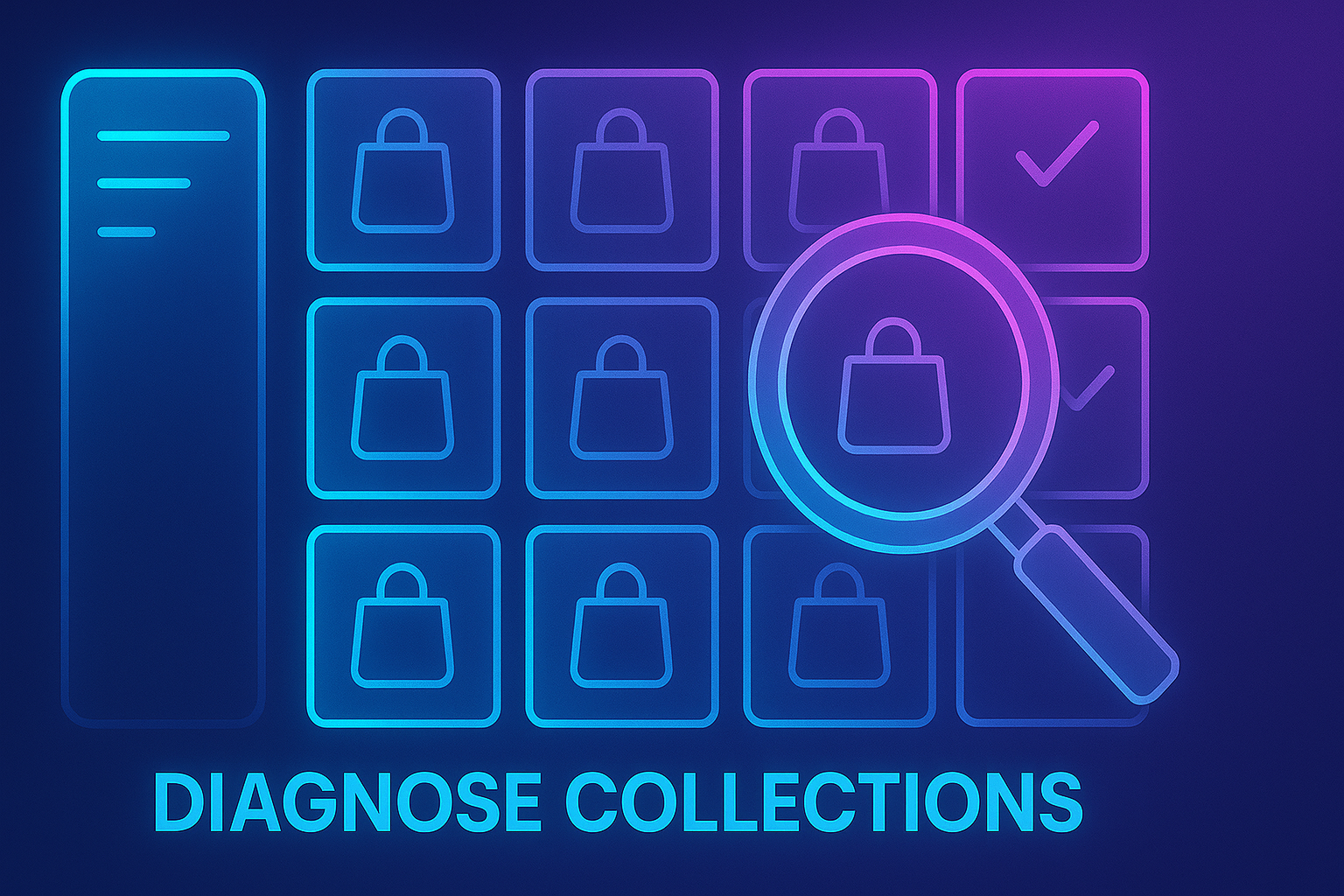A no-dev workflow to audit and fix Shopify collection issues in minutes—covering crawling, indexing, filters, canonicals, speed, and UX using SEO Horizan tools
Shopify stores guide: Diagnose collections without a developer (2025)
Collection pages drive most category traffic for Shopify stores—but filters, pagination, and theme customizations can quietly tank visibility. This hands-on guide shows a no-developer workflow to diagnose and prioritize fixes in minutes using SEO Horizan and your Shopify admin.
What counts as a “collection issue” in 2025?
- Duplicate variants: Filtered URLs (e.g.,
?filter.v.availability=1,?sort_by=best-selling) get indexed without canonicals. - Weak titles/snippets: Generic collection titles or missing descriptions kneecap CTR.
- Thin content: Zero intro copy; grid only. No internal links to sub-collections or top products.
- Redirect hops: Old /collections aliases or tag URLs that 301/302 before landing.
- Slow grids: Heavy images, bloated apps, or endless JS delaying content.
- Broken pagination semantics: Infinite scroll with no crawlable pagination or canonical consolidation.
Why collection health matters now
- Ranking stability: Clean canonicals and restrained indexation stop dilution across filters.
- Conversion: Clear titles, curated intro text, and internal links improve click-through and AOV.
- Scaling SKUs: As catalogs grow, small technical leaks compound fast.
How to diagnose Shopify collections (10–30 minutes, no dev)
Run this workflow weekly or before seasonal campaigns.
Step 1: Baseline the live collection
- Open the collection URL and check Title/Description/OG with Meta Tags Checker and OpenGraph Checker.
- Extract on-page copy to see what search engines read using Website Text Extractor.
- Preview the snippet with Google Search Preview (optionally Bing/Yandex previews).
Goal: Confirm the page has a descriptive title, a 1–3 sentence intro, and scannable headings.
Step 2: Hunt down duplicate/filtered URLs
- Apply a sort or filter in your collection and copy the resulting URL.
- Run it through URL Redirect Checker to see if it resolves directly or hops.
- Open HTTP Headers Lookup for the filtered URL and the clean collection. Check
status,canonical(via HTML), and verify that filters don’t claim self-canonical if you want consolidation.
Step 3: Validate pagination & “view” parameters
- Navigate to page 2 (e.g.,
/collections/shoes?page=2). Confirm it resolves and isn’t blocked by robots/noindex using Noindex Checker. - If your theme uses a
?view=parameter (e.g., quick-view or alt templates), check that these don’t index as separate pages.
Step 4: Speed & payload sanity
- Measure server time and payload via TTFB Checker and Website Page Size Checker.
- Spot images that need compression or modern formats; confirm HTTP/2 and Brotli with the respective tools (if enabled in your stack).
Step 5: Content & internal links (non-dev)
- Add 60–120 words of intro copy at the top (brand voice + category qualifiers).
- Insert 3–5 internal links to sub-collections, top product types, or buying guides.
- Ensure images used as links have descriptive
altvia Image Alt Tags Checker.
Step 6: Re-check index signals
- Re-run the clean collection and a couple of filtered URLs in Meta Tags Checker.
- Confirm canonical on filtered/sorted pages points to the clean collection URL (or is noindex if your strategy demands it).
Copy-and-paste checks for your Shopify team
Collection header copy (starter)
<div class="collection-intro">
<p>Discover our curated selection of [category]: best-sellers, new arrivals, and editor’s picks.
Filter by size, color, or price—then explore guides and sub-collections for faster decisions.</p>
</div>
Internal links block (grid footer)
<aside class="related-cats">
<h3>Explore more</h3>
<ul>
<li><a href="/collections/[sub-collection-1]">[Sub-collection 1]</a></li>
<li><a href="/collections/[sub-collection-2]">[Sub-collection 2]</a></li>
<li><a href="/blogs/news/[buying-guide]">Buying guide: [Topic]</a></li>
</ul>
</aside>
Prioritization (quick triage)
Issue, Symptom, Impact, Action
Filtered URLs indexed, Duplicated pages for sort/filter, High, Canonical to clean collection or noindex filters
Thin collection, Grid with no intro/links, Medium-High, Add intro copy + 3-5 internal links
Redirect hops, Old aliases or tags, Medium, Update internal links to final 200
Slow payload, >2MB or TTFB >600ms, High, Compress hero, limit apps, lazy-load
Pagination blocked, Page 2 not indexable, High, Ensure crawlable & consistent canonical
Publishing checklist (don’t skip)
- ✅ Title/Description/OG validated with Meta Tags & OpenGraph.
- ✅ Clean collection has 60–120 words of intro + 3–5 internal links.
- ✅ Filtered/sorted URLs do not self-canonical unless intentional; otherwise canonical to clean collection or noindex.
- ✅ No redirect hops on internal links (checked via URL Redirect Checker); headers confirmed with HTTP Headers Lookup.
- ✅ TTFB/Page size in healthy range (TTFB, Page Size).
- ✅ Image links have meaningful
alttext (Image Alt Tags Checker).
Where to link internally (support collection SEO)
- Cluster guides on your Blog to support collections with educational content.
- Link collections to sub-collections and top product-type pages to clarify hierarchy.
- Ensure all collection roots are present in your Sitemap.
SEO Horizan Toolbox (use during audits)
- Website Text Extractor • Meta Tags Checker • OpenGraph Checker
- URL Redirect Checker • HTTP Headers Lookup • Noindex Checker
- Text-to-HTML Ratio Checker • TTFB Checker • Website Page Size Checker
- Google Search Preview • Bing • Yandex
FAQs
Should filtered collection URLs be indexed?
Generally no. Canonical them to the clean collection or apply noindex to prevent dilution—unless a filter has unique search demand and custom content.
Do I need a developer to fix collection SEO?
Not for the basics: titles, intro copy, internal links, and canonical/noindex strategies can be managed in the admin or theme settings. Reserve dev time for template or app-level changes.
How much copy is enough on a collection?
60–120 words near the top with 1–2 relevant headings is a safe baseline; add a link block to sub-collections or guides.
Is infinite scroll bad for SEO?
It’s fine if accompanied by crawlable pagination or a view-all page; otherwise crawlers may miss deeper products.
Wrap-up
Healthy collections win the SERP and the cart. Audit your titles, canonicals, filters, and speed; add intro copy and internal links; and lock down pagination signals. Want a faster, repeatable process? Sign up or compare Plans to operationalize audits and QA.
